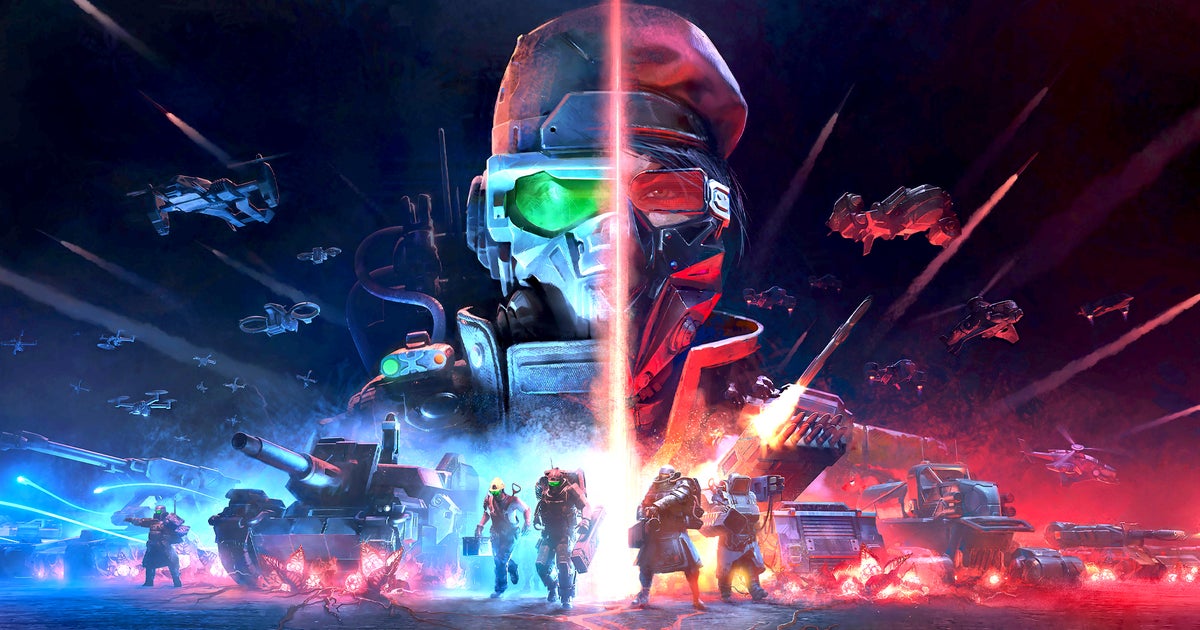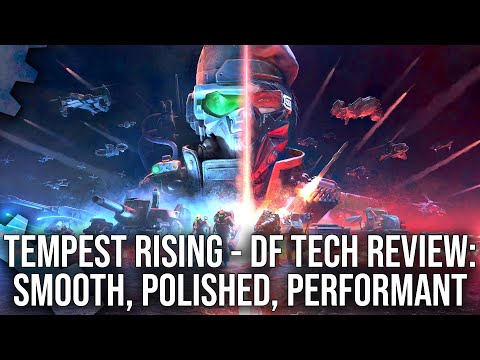Tempest Rising is a polished, performant and brilliant real-time strategy (RTS) game powered by Unreal Engine 5. That’s a sentence I never really expected to say just a few years ago, but a whole host of contributing elements here make this game fun to play and, thankfully, technically sound. This is not typical multi-platform game that I’d review for DF, but a PC exclusive in a genre that defined the platform’s earliest days. Slipgate Ironworks and 3D Realms have crafted a new entry into that classic genre that lives up to the legacy of its finest works, and I think a big reason for that is due to the incredible single-player focus.
While you can of course play the game in a skirmish against the CPU or in multiplayer, what sets Tempest Rising apart from many modern entries in the RTS genre is its intricate 22-mission campaign. Like some of the most legendary RTS games, you have a choices of factions: the NATO-adjacent, high-tech and synergistic Global Defence Force or the Tempest Dynasty, an eastern/southern force with heavy weapons platforms and flamethrowers.
This dichotomy might sound familiar and that’s purposeful, with the game’s developers being open about their inspiration from Command and Conquer, and the storyline isn’t far removed from the beats found in the first two games in that series. A devastating nuclear war has led to the spread of the veiny, organic and titular “tempest” across the globe, a sci-fi lifeform whose byproduct conveniently acts as a fuel source and weapon. The two factions vie for the future of the species by fighting over the remaining land and resources.
The game’s interstitial story moments also feel like something ripped right out of the first Command and Conquerr, albeit with more modern technology. Instead of filmed FMVs, these sequences are instead rendered in real time, with digital actors representing ranking leaders or second-in-commands that brief you on your mission and optionally give you more information and context about the world and your objective. From here you can see your next mission laid out in front of you on a animated geographical map, and upon deploying you’re treated to a short FMV sequence where new unit types are shown off and the combat scenario ahead is prepped.
Each mission is quite different from the last, and the variety is only enhanced by the different factions where the story and playstyle vastly differ. Even the entire aesthetic to the intermission sequences are different, with GDF’s cold blue holograms being replaced with charmingly old-school, Cold War era DOS prompts for Tempest Dynasty. It’s simply wonderful.
The units, backstory and gameplay are of course all new here for Tempest Rising, but the cadence and presentation of the story will be incredibly familiar to those of you who have played Command and Conquer. For someone like me, this isn’t an issue but a plus point, as Command and Conquer hasn’t had a decent new entry in decades, and meaty single-player campaigns with this much story and production value are quite uncommon in RTS, especially non-historical entries.
While the cinematic influence and story-telling style come from Command and Conquer, other areas of the game are inspired by more diverse sources. Yes, there’s plenty of Command and Conquer here, but aspects like tech research, unit abilities and the presence of a population cap is more Blizzard-like, while mission rewards and attributed bonuses allocated to your units out of combat are something you might find in a game from Relic or Creative Assembly.
The influences run deep and, like the best games in the genre, the moment-to-moment gameplay requires your full concentration even on normal difficulty. You have a lot to account for: making sure your resources are accruing, expanding your base, making the most of your unit abilities and spacing your forces for attack or defense. I was extremely rusty when the game started to get more hectic and I was quickly overwhelmed by the amount of things you can micromanage. After some floundering on my part I discovered the rhythm of the game, and started to better understand how to pace macro and micro. Still, I should stress that the game can be difficult. The campaigns start simply, with few units to control, but this ramps up progressively throughout the campaign. It’s challenging and rewards mastery, which I’m sure genre veterans will greatly appreciate.
From a Digital Foundry tech perspective, there’s plenty to talk about here, with the game shipping on Unreal Engine 5.4.3, according to its executable, and offering the choice of DX11 or DX12 modes. I opted for DX12, and while the initial shader compilation step did disrupt the playback of the intro videos somewhat, it does appear to be effective, with no instances of shader compilation stutter whatsoever in a dozen hours of play. The game in general is smooth and fast, and load times from the main menu took just two seconds on a Ryzen 7 9800X3D processor with a PCIe 4.0 NVMe SSD, with a similar figure for reloading mid-game. Save-scumming in the event of a failed attack has never been easier!

In terms of graphics, the game is a bit more modest, which explains its relatively kind performance profile – as I’ll discuss later. Based on a visual examination, the game doesn’t appear to take advantage of the headline UE5 features such as Lumen, Nanite or Virtual Shadow maps despite being a UE5 release. However, these features aren’t key for Tempest Rising’s RTS gameplay and isometric perspective, where lighting nuances, level of detail swaps and geometric quality aren’t key to the game’s aesthetic. The game does appear to use a standard level of detail system, which subtly swaps assets based on camera distance – and this doesn’t hurt the game’s visuals versus more advanced systems. The only standard UE5 feature that could have improved the presentation is probably VSMs, as the shadow quality could be more precise, but this is a relatively minor critique.
Everything you control looks great, with units that have distinctive enough silhouettes at maximum zoom to easily distinguish and control. One of my favourite elements is the headlights on vehicles, which light up the surrounding terrain and objects as they bounce around the environment. Explosions and particle effects are another high point in the game’s visuals, with oil barrels, fuel depots and the game’s various structures detonating wonderfully with big sparky fireballs like Quake 2. It’s key for a game like this to have satisfying effects work, and clearly the developers spared no expense in making sure all the booms and bangs look great.
Backing up the explosive action is a solid soundtrack with diverse tracks and several composers. I particularly like that the music plays with the correct context, eg heavy guitar-driven tracks emphasise a battle scenario, while more stealth-based missions have appropriately ambient backing tracks. There’s music for a variety of occasions and even some tracks from Command and Conquer’s Frank Klepacki that go as hard as you’d imagine. While playing, you’ll probably find yourself nodding your head to the beat in the same way that you might have done in a classic RTS of yore.

Plenty is done well on the presentation side, but I’d be remiss not to mention a few nitpicks. One is how textures load, where quickly clicking across the map can catch textures loading in just after you change viewpoints – not super common in regular gameplay, but still a bit surprising to see.
Another issue is more common: animation rate. A large number of game animations appear to occur at half-rate, so a unit moving across the battlefield will change position at 60Hz, for example, but only animate at 30Hz. The intensity of the animation affects how obvious this is, eg helicopter blades are quite a stark example. Other elements, like particle effects and flip book animations, also seem to be half-rate. There doesn’t seem to be much rhyme or reason as to which animations are decimated in this way – eg turrets run at half-rate, while barracks animate at full-rate.
Thankfully, higher refresh rates mean smoother half-rate animations, eg playing at 120Hz means half-rate effects run at 60Hz, where the animation inconsistencies are les obvious. I’m not sure if this is an intentional performance saving measure given how inconsistently it’s applied, but either way it would be cool to be able to manually enable full-rate animations throughout the game for higher-end hardware.



I spent a healthy amount of time playing at a locked 4K 120fps, and had a fantastic experience on a high-end RTX 5090 and Ryzen 7 9800X3D rig. There were zero dropped frames over a 30-minute span, with GPU utilisation topping out at 70 percent and CPU utilisation also quite low. Some of this performance comes from the fact that the game isn’t taking advantage of the highest-end UE5 features, but we’ve seen several games that perform much worse while using a similar feature set, typically due to poor CPU utilisation. Either way, the development team appears to have made the correct technical decisions to serve the gameplay, and on high-end hardware the game truly flies and is incredibly smooth with no frame-time issues to worry about.
On lower-end hardware, you don’t have to make settings concessions to hit performance targets, but large numbers of on-screen units and their AI calculations can cause slow-down on older and slower CPUs. For example, a relatively low-end RTX 3060 is able to hit 90-120fps using epic settings at 1440p with DLSS quality mode, which is fantastic, but the similar vintage Ryzen 5 3600 processor often kept the graphics card at 70-80 percent utilisation. When you order a full screen of units to attack-move to an enemy base, I saw the frame-rate tumble below 60fps with spiky frame-times. However, most gameplay was well above 60fps, and the isometric camera makes any frame-rate hiccups less noticeable than in a game with a first-person or third-person perspective.
Beyond performance, I want to discuss how well Tempest Rising makes use of ultra-wide monitors. In gameplay, the UI is pushed out to the edges to make good use of the space, contextual menus appear in the correct location and the experience is polished – something that sometimes even big-budget releases don’t manage. However, outside of the core gameplay, there are some compromises: the 16:9 map screen is zoomed in to fill the extra space, talking head moments use huge vignettes on the left and right sides to presumably avoid animation weirdness that would be otherwise off-screen, and FMV sequences get classic black bars.

However, the ultra-wide experience is still better than the current HDR implementation, which seems buggy. HDR does work when you load up the game, as the monitor detects it, but as soon as you are in-game, it’s easy to see how things aren’t rendering correctly – for example, snowy terrain looks red in HDR. It’d be great to see the development team provide proper HDR support down the line.
Tempest Rising is, bar some smaller things, an extremely polished and performant game that plays extremely well. Its fully-fledged single-player campaign is a treat and I highly recommend this game to anyone out there who like real time strategy games. In an era where publishers and studios such as EA and Blizzard have categorically ignored making new entries into classic franchises, it is incredible to have a game of this high quality coming out doing the things it does.

